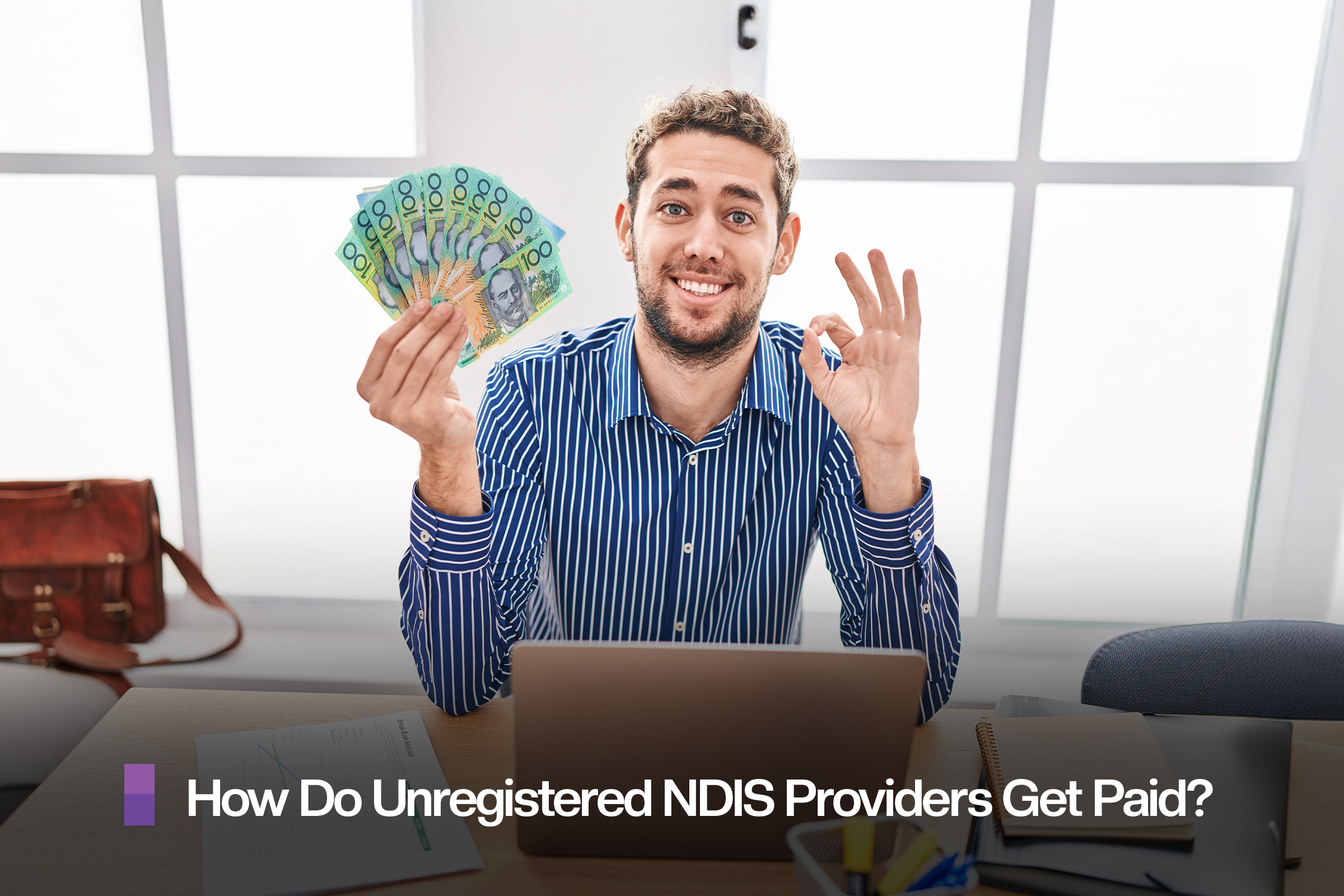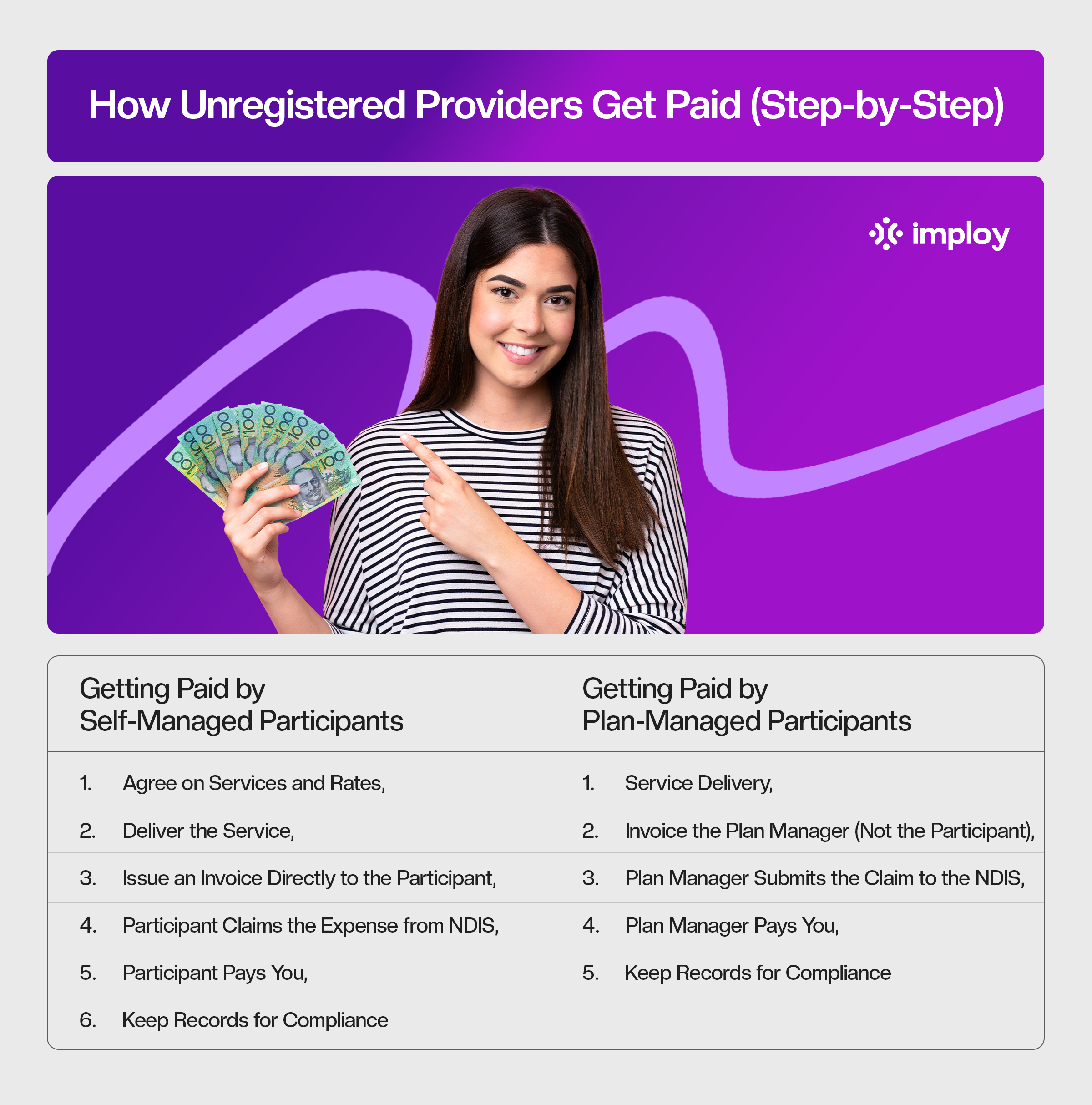How Do Unregistered NDIS Providers Get Paid?
Discover how unregistered NDIS providers get paid. Learn who can pay you, how invoicing works, and tips for faster, smoother payments.

Many support workers and small businesses deliver quality services under the NDIS without being formally registered. But one question often comes up - how do unregistered NDIS providers get paid?
If you’re new to the NDIS space or running your own independent support business, understanding how payment works is essential for maintaining compliance and ensuring smooth cash flow.
In this guide, we’ll explain who can pay you, how the payment process works, and what you can do to make invoicing and getting paid simpler.
Understanding the Difference Between Registered and Unregistered Providers
Under the National Disability Insurance Scheme (NDIS), providers can either be registered or unregistered:
- Registered providers are approved by the NDIS Quality and Safeguards Commission. They can work with all participants, including those whose plans are managed by the NDIA.
- Unregistered providers, on the other hand, are not officially registered with the Commission but can still offer supports to participants who self-manage or use a plan manager.
The key difference lies in who you can work with and how you get paid.
Related Reading: Learn more about the key differences in our detailed guide - Registered vs Unregistered NDIS Providers.
Thinking about becoming a unregistered provider? Read our step-by-step guide on How to become an Unregistered NDIS Provider.
Who Can Pay an Unregistered NDIS Provider?
The type of NDIS plan a participant has determines how unregistered providers receive payment. Here’s a quick overview:
So, if you’re an unregistered provider, you can only work with self-managed or plan-managed participants.
How Unregistered Providers Get Paid (Step-by-Step)
Getting paid as an unregistered NDIS provider depends entirely on how your client’s NDIS plan is managed. Since you can only work with self-managed and plan-managed participants, the process is different for each - but both are quite straightforward once you understand the flow.

Let’s look at how each payment pathway works in detail.
1. Getting Paid by Self-Managed Participants
Self-managed participants have full control over their NDIS funds. This means they can directly choose, engage, and pay any provider - whether registered or not.
Here’s how the payment process usually works:
- Agree on Services and Rates
Before starting, discuss what supports you’ll provide, your hourly rate, and how you’ll invoice. It’s best to have a simple service agreement outlining this.
- Deliver the Service
Provide the agreed supports - whether it’s personal care, community access, therapy assistance, or household help.
- Issue an Invoice Directly to the Participant
After the service, send your invoice directly to the participant. Make sure it includes your ABN, their NDIS number, service dates, description, and total cost.
Need a ready-to-use format? Download imploy’s Free NDIS Invoice Template.
- Participant Claims the Expense from NDIS
The participant logs into their myplace portal, submits your invoice, and claims the cost from their NDIS budget.
- Participant Pays You
Once the NDIS reimburses the funds, the participant transfers payment directly to your nominated bank account - usually via bank transfer.
- Keep Records for Compliance
Store all invoices, service agreements, and communication records securely. This ensures you’re audit-ready and can easily track your income.
2. Getting Paid by Plan-Managed Participants
Plan-managed participants work with a Plan Manager - an intermediary who handles all financial aspects of their NDIS plan.
Plan Managers are essentially small financial services providers that receive the NDIS funds, pay invoices, and keep track of the participant’s budget.
Here’s how payment works in this case:
- Service Delivery
You provide the agreed service to the participant, just as you would for a self-managed client.
- Invoice the Plan Manager (Not the Participant)
Send your invoice directly to the Plan Manager’s email. The invoice should include:
- Participant’s full name and NDIS number
- Your ABN and contact details
- Service type and support item code (if known)
- Service dates, rates, and total cost
- Plan Manager Submits the Claim to the NDIS
The Plan Manager checks the invoice to make sure the service fits within the participant’s budget and plan.They then claim the amount from the NDIS.
- Plan Manager Pays You
Once the claim is processed, the Plan Manager pays you directly, usually within 3-10 business days.
- Keep Records for Compliance
Store all invoices, service agreements, and communication records securely. This ensures you’re audit-ready and can easily track your income.
Need help preparing for audits? Explore imploy’s NDIS Audit Support Resources.
What Should an Invoice Include?
Before you can get paid, you’ll need to issue a proper invoice - and getting this right is key to ensuring smooth, timely payments. Whether your client is self-managed or plan-managed, providing all the necessary details upfront prevents delays, avoids confusion, and shows that you operate professionally.
To get paid promptly, your invoice should include:
- Your business name, ABN, and contact details.
- The participant’s name and NDIS number.
- Service dates and description of supports provided.
- Hourly rate and total amount due.
- Payment terms and bank details.
A clear and professional invoice helps plan managers and participants process payments faster.
Pro Tip: Download imploy’s Free NDIS Invoice Template to make sure your invoices meet NDIS standards.
Common Payment Challenges (and How to Avoid Them)
Even experienced providers face issues with payments. Here are some common challenges, and how to prevent them:
If you’re struggling with documentation or compliance, imploy can help you stay organised and audit-ready.
Can Unregistered Providers Charge the Same Rates?
Unregistered providers are not required to follow the official NDIS Price Limits, which means you have more flexibility to set your own rates. This can be an advantage, especially if you offer specialised services, work in regional areas, or provide care outside standard hours.
However, with that flexibility comes responsibility. It’s essential to ensure your rates are fair, transparent, and clearly communicated to participants. Participants using self-managed or plan-managed funding can choose to work with unregistered providers, but they must agree to your rates before services begin.
To maintain trust and professionalism:
- Discuss your hourly rate and any additional costs (like travel or cancellation fees) upfront.
- Clearly outline all charges in a written service agreement.
- Avoid sudden price changes without prior notice.
- Provide detailed invoices that align with what was agreed upon.
Remember, most participants refer to NDIS pricing as a guide, even when working with unregistered providers. Charging significantly higher rates may discourage clients or raise questions about value.
Reference: You can view the official NDIS Pricing Arrangements and Price Limits 2025-26 to understand the benchmark rates used across the sector.
Final Thoughts
Becoming (and staying) an unregistered NDIS provider offers flexibility, independence, and lower administrative costs, but it also requires strong business practices. Getting paid on time depends on how well you manage invoicing, communicate with clients, and maintain professionalism in every interaction.
While registration isn’t mandatory for working with self-managed or plan-managed participants, it’s still important to operate transparently, keep clear records, and follow NDIS standards. Doing so not only ensures smooth payments but also builds trust and credibility with clients and plan managers.
If you’re planning to grow your business or attract a wider client base, consider whether becoming a registered provider could benefit you in the long run. Registration opens access to NDIA-managed participants, adds credibility, and can make your services more appealing.
FAQs
1. Can unregistered NDIS providers work with all NDIS participants?
No. Unregistered NDIS providers can only work with self-managed and plan-managed participants. NDIA-managed participants must use registered providers only.
2. Do unregistered NDIS providers need an ABN?
Yes. You must have an Australian Business Number (ABN) to issue invoices and receive payments legally. This applies whether you’re a sole trader, partnership, or small business.
3. Can unregistered providers charge higher rates than the NDIS Price Limits?
Yes. Since you’re not bound by the official NDIS Pricing Arrangements, you can set your own rates - as long as they are reasonable, transparent, and agreed upon in advance with your client.
4. Do unregistered NDIS providers need insurance?
Absolutely. Even though registration isn’t required, you should still have Public Liability and Professional Indemnity insurance to protect yourself and your clients. Many plan managers also request proof of insurance before processing payments.
5. How can imploy help unregistered providers get paid faster?
imploy offers tools for creating NDIS-compliant invoices, tracking payments, and storing service records securely, so you can reduce admin time and improve cash flow.





